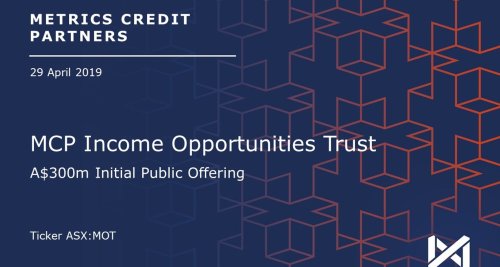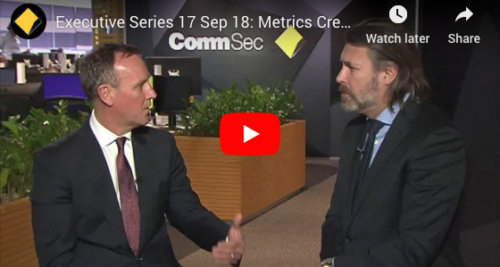Property Point: A LIT non-bank lender
Eureka Report, Podcast with Laura Daquino – 09 September 2019
Laura Daquino chats with Andrew Lockhart, Managing Partner of Metrics Credit Partners, about two listed investment vehicles filling a fixed income gap.
Hi, I’m Laura Daquino, welcome to Property Point. Today I’m interviewing Andrew Lockhart from Metrics.
Metrics is the largest non-bank lender to corporates on the ASX. Metrics offers a full suite of debt products from high-investment grade corporate debt, through to deep sub-investment grade debt with an attached equity interest.
The company funds corporates and is active across development funding, high-rise hotels and sub-divisions. They have projects and infrastructure funding facilities too. They lend to property groups like Charter Hall.
For the purpose of our interview, we’re focusing on the MCP Master Income Trust and MCP Income Opportunities Trust. These are listed investment trusts on the ASX trading under tickers, MXT and MOT.
These alternative listed products – being LICs, LITs and ETFs – are seeing spectacular growth. In the June quarter, listed investment companies and listed investment trusts grew 6.7 per cent in size to $45.1 billion under management.
So far this calendar year, capital raised for LIC and LIT IPOs has outstripped other ASX IPO capital. MOT was the second biggest of these new listings. The team was successful in their mission to raise the maximum subscription of $300 million. MOT launched in April under the ticker MOT.
Here’s Andrew Lockhart, Managing Partner of Metrics Credit Partners.
Andrew, you established Metrics as a non-bank lender to corporates in June 2013 with a couple of co-founders and one investor with $75m. How much has the business grown since then?
Since June ’13 we’ve grown quite substantially. We have increased from one individual fund with one investor for $75 million, to now operating 10 different fund vehicles and around about $5 billion in assets under management, so the business has grown quite substantially with two ASX listed funds being the MCP Master Income Trust (MXT) and the MCP Income Opportunities Trust (MOT) forming part of that growth of the business.
Can you explain where those two ASX-listed products, which should be of most interest to our listeners, actually sit on the risk spectrum? I understand one might be slightly riskier than the other?
Sure. With MXT, the MCP Master Income Trust, that fund was really designed to give investors a traditional fixed income replacement. We sort of feel that a lot of investors, up until the launch of that fund in October of 2017, had a lot of exposure to hybrids or term deposits but find it very difficult to get a well-diversified spread of corporate exposure or bonds or loans and so MXT was designed to provide investors with that traditional fixed income asset allocation alternative where they can invest in MXT and get a medium diversification across a broad range of borrowers but in terms of credit quality and industry diversification and borrower diversification. It really provides an alternative way for investors to get exposure to that market, which really up until the time that fund listed was very difficult for most investors to gain exposure to because a lot of corporate borrowers raise money through bank loans and so the ability to gain exposure to Australian corporate credit was quite difficult until the launch of MXT.
With MOT, it’s designed to really provide investors with an equity alternative. A lot of investors worry about the level of market volatility they’re exposed to through public market equities and looking for lower risk ways in which to generate an acceptable equity-like income. The MCP Income Opportunities Trust was really designed for investors looking to lower their equity market exposure, moving into the lower risk part of the capital structure of a company where we lend to companies.
So, the companies that we lend to there, we’re providing loan funding, but we seem to provide investors with an equity-like return through higher yielding or subordinated or sub-investment grade debt. We lend to sub-investment grade companies, we do senior debt, mezzanine and subordinated debt, really where the return on the debt is higher, representing the increased risk of lending, but also looking to acknowledge the fact that a lot of companies find access to debt capital quite difficult and so we think sometimes capital is restricted by banks and as a result of that, we’re able to negotiate higher rates for lending than we might otherwise be able to achieve.
We also look to provide our investors with upside participation through participating in instruments such as options or warrants where we’re able to negotiate an outright equity ownership interest in the company that we’ve leant to as well.
I’ve heard some of your products being referred to in the market as an alternative to term deposits, and I know you probably wouldn’t say that necessarily because they are higher risk, but the way you’re talking about them now, they are relatively low risk in some respects compared to investing in equities, if I’m correct?
That’s 100 per cent correct. A lot of Australian investors have exposure to public market equities and they think that investing in debt is often scary or higher risk, but really where you sit in the capital structure and having appropriate risk management and controls in place, so when we lend to a company obviously the highest risk part of the capital structure is actually the equity. And so, the volatile asset class should always be the equity. People often invest in equity for growth in capital. What we’re providing our investors with is a lower risk position in the capital structure often through secured loans that we’ve made to companies. If you think about it, it’s a property related transaction and the loan to valuation ratio might be 60 per cent, so 40 per cent of the capital structure is actually at risk to equity before there’s a risk to our position as a lender.
And so, you can sustain a substantial fall in valuations or a deterioration in credit quality before you’re at risk of losing money. Whereas, in an equity, you’re the first loss in terms of the capital structure.
I wanted to ask you actually about property exposures and how big of an allocation you have to the property sector across the two listed funds? I understand property is one of your key markets, so does property sit in both MXT and MOT?
Yes, it does. As a business where around about 30 per cent of our portfolio is exposed to property related transactions, we’re active across a range of sectors. We do residential, we do land subdivision and financing. We provide financing for high-rise residential apartments and we also provide funding for industrial and commercial purposes. Currently we don’t have any retail property exposure in our portfolio. We also lend to for investment purposes, so where investment grade real estate investment trusts borrowing money across a diversified pool of income producing properties, we’re often a lender in those transactions as well. And yes, MOT and MXT both have exposure to property through our real estate debt fund, where we lend both at a senior level and also mezzanine, and increasingly also looking to participate alongside some of our developers where we can negotiate some equity upside for our investors.
Is that 30 per cent exposure lower than what it used to be because of what’s happened to the property market, or have you kind of just mixed it up where you’ve maybe switched out of residential or retail investments to industrial investments?
No, we’ve been active in all parts of the market. What we’ve found is over the last four years or so the banks have been subject to sort of increasing regulatory pressure and as a result of that, making it more difficult for a lot of borrowers to access debt finance, the terms and conditions tightened, but the withdrawal of bank capital has meant that the pricing of that debt has become more attractive to us as a non-bank lender. And so, in the last four years, we’ve actually moved from a position of being relatively underweight property-related loan transactions to moving to around about a 30 per cent weighting across our portfolios as the banks have withdrawn capital from that sector.
You compete with the banks, but you’re also partnering with the banks, and on those deals was there a turning point that you can remember in recent years where you started to become a bigger partner on them? Was it around the Royal Commission?
No, it was actually prior to the Royal Commission, but we were approached by one of the banks that we partner who was involved in a large syndicate with a number of banks. This particular developer I think was up to about their eighth stage of the transaction and one of the four major banks had to withdraw from the transaction because they’d reached their limit in terms of the industry exposure. And so we were asked to come along and join the banks in providing the funding for that facility.
When was that?
That would have been probably 2015 I’d guess. The interesting thing that occurred in that situation was, we came in, we filled a gap in the funding profile for the corporate client, but then had gone on and done a lot of business with that particular company, where we’ve been an active lender for them. So it’s sort of interesting how an opportunity presented itself, we’ve created a great relationship with that borrower and then sought to do a number of transactions with them over the years.
That is interesting. Could you maybe also expand on – Australia’s corporate insolvency laws, I know that that might actually put Metrics in better stead, I’ve been reading up about it. There’s a greater ability in Australia to take security over a company and wipe out layers of debt, but can you actually explain to us what that means in Metrics terms at a layman’s level?
Yeah, sure. It’s probably one of the under appreciated protections that are available to our investors. Where a lender is secured, you obviously rank highest in the pecking order in terms of the capital structure of a company. If a company was to get themselves into difficulty and credit quality deteriorated, there’s generally a few things that a lender would do. One, you’d ask the borrower to try and raise additional equity using those proceeds to repay part of your debt. If the borrower can’t raise additional equity, then often what a lender would do is force an asset sales process, so encourage the borrower to sell assets using the proceeds from the sale of assets to repay debt. If the borrower couldn’t do either of those two things then often a lender might have to take control of their security and then force under their securities.
Under Australian corporate insolvency law, if you’re a secured creditor and you have effective security, then obviously you can take control of the company that you lend to or take control of the property that you’ve got a mortgage over, look to either sell that asset or to restructure the debt where you might end up taking control of the company and converting the debt to part debt/part equity. There’s a range of things from our perspective that are very attractive around Australian corporate insolvency laws, but one of the things that differentiates us from the banks is because the banks are regulated and they’re heavily geared. Banks are
highly levered in their own right, and so the regulators require them to increase the level of capital that they hold against individual assets. If the credit quality of a borrower deteriorates, the banks are required to hold more and more capital against that borrower, recognising the potential risk of loss. It gets to a point where it becomes uneconomic for a bank to hold those assets and they end up being almost forced sellers. Then when a bank thinks about restructuring an asset, they’re often not able to hold or restructure where they might end up holding equity in a company, because the risk weighting of the capital required is quite great.
And so, they tend to be sellers of credit quality, rather than working through a restructure and protecting capital. They’re often motivated to look to sell the asset quickly or sell the loan, get out their exposure quickly regardless of the potential risk of loss of capital to them. Whereas, for us, we can take a longer-term view, seeking to ensure that our investors capital is preserved through proactive risk management processes that we operate.
That bank situation, that’s clearly to your advantage and ultimately or hopefully it’s to the investors advantage too. There’s also other advantages from investing I know in a LIT rather than a LIC. Can you explain the tax differences with respect to this?
Yeah, look, I think for our product range, a listed investment trust is the most appropriate way for an investor to gain exposure because all investors might have different tax requirements and importantly, all the income that we generate in a trust has to be distributed to our investors. Tax is payable in the hands of the investor at the marginal tax rate, or if it’s a super fund or a self-managed super fund as part of the earnings of those funds, they’ll pay tax based on their own individual circumstances. But importantly for us, what it means is that we don’t have the ability to smooth investor returns or we don’t have the ability to withhold the income that’s being generated on our activities and payout investors at a different time period.
Often in a listed investment company the manager might be incentivised to increase the level of capital, so withhold earnings, because as the size of the company increases, so does their business. For us, we’ve raised a certain amount of capital, we generate a return for our investors on that capital, and the full amount of the net operating income that is generated is paid out to our investors every year. In MXT we pay away those distributions every month, and in MOT we pay away the net operating income distributions on a quarterly basis.
What have the returns been like for both those vehicles over the last 12 months, say?
With MXT, we target a minimum target return to investors of the RBA cash rate plus 3.25 per cent, net of all fees and costs, with income pay away on a monthly basis. Since inception of the fund back in October of 2017, we’ve exceeded that by between 0.75-1 per cent over the minimum target return, so investors have had a strongly performing investment fund. In MOT, we completed the capital raising for that fund on the 29th of April of 2019, so we raised $300 million for that vehicle. The minimum target return for the investors is a 7 per cent per annum, with that being the cash income and we expect to pay away that cash income on a quarterly basis and we look to provide our investors with the rights to participate in upside gains. So, if we’re successful in negotiating income or opportunities where we can increase the earnings of the fund, we look to sort of target the total return to the investors of around about 10 per cent per annum over a medium-term horizon.
Are you on track for that, or how was it to June 30?
Yeah, we are. I think as at June 30 we’re just a little bit shy of the 7 per cent per annum, but you’ve got to remember that’s two months after listing, so obviously we’ve raised the capital, the kinds of transactions we’re involved in do take time to negotiate. So often when we’re looking to enter into a transaction with a borrower, it might take us anywhere between a month to in excess of 12 months to complete a transaction with the borrower, so there’s a little bit of a lag and a lead time in terms of being able to fully deploy the capital. But we’re on track to generate those kinds of returns subject to continuing attractive lending opportunities.
From our perspective, far better to preserve and maintain our investors capital than driving an acceptable return based on the risk than taking additional risk just in the hope of trying to outperform a return target.
So, from our perspective I think we’ll deliver the returns for investors over the medium to longer term just in the short period it may just be a bit of a situation where we’ve got a bit of a lag in terms of full deployment of the capital.
Well, we might leave it there for today, but best of luck, Andrew, with balancing that risk/reward and thanks for the chat.
Thanks, Laura, appreciate it.
That was Andrew Lockhart, Managing Partner of Metrics Credit Partners.
https://www.investsmart.com.au/investment-news/property-point-a-lit-non-bank-lender/146099
Other News
Podcast: The Rules of Investing | From Cold Call to Capital Giant
In this episode of The Rules of Investing, Metrics Group CEO & Managing Partner, Andrew Lockhart discusses the conditions that…
Metrics Credit Partners Completes Acquisition of Taurus and BC Invest
Metrics Credit Partners (“Metrics”), a leading Australian based alternative asset management firm, has today successfully completed the acquisition of Taurus…
INSIGHTS
MCP Income Opportunities Trust (MOT) lists on ASX
Sydney, 29 April 2019: The Trust Company (RE Services) Limited (ABN 45 003 278 831) (Responsible Entity) is the responsible…
MCP Master Income Trust wins Lonsec Listed Fund Award
The award came a year after MXT was listed on the Australian Securities Exchange






